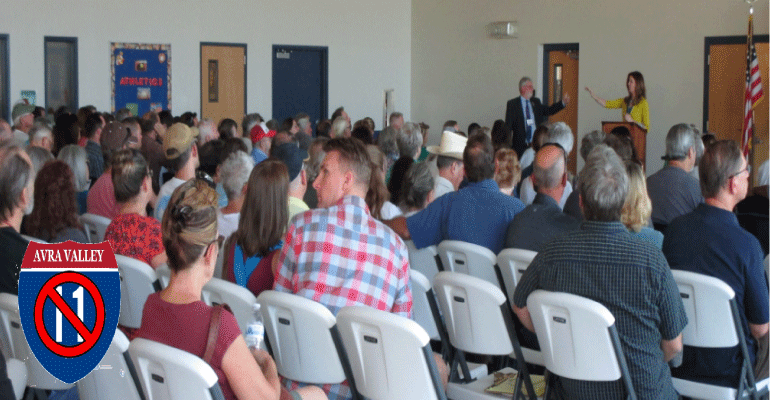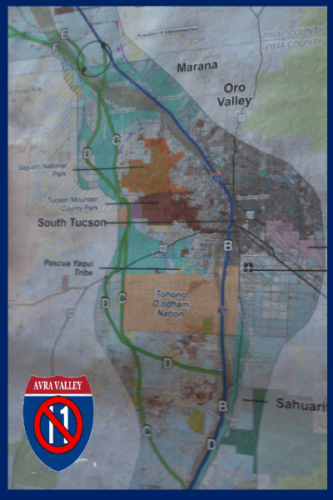
Over 400 people attended Arizona Department of Transportation public meetings in Tucson and Marana on Interstate 11 alternative routes. The meetings are required as part of the $15 million, three-year, Tier One Environmental Impact Study now in its second year. While ADOT is accused of dragging its feet on actually organizing a large turnout, groups opposed to any I-11 route through the Avra Valley west of the Tucson Mountains were able to mobilize their supporters. As happened with the first round of public meetings a year ago, a clear majority of those who did attend the meetings opposed the highway.
The May 2 meeting at Tucson’s Riverpark Inn saw Avra Valley Coalition members Robin Clark and Albert Lannon handing out informational flyers, with environmentalist Kevin Dahl passing out colorful “No Freeway in Avra Valley” stickers that attendees immediately pasted to their shirts. Very few people refused to take a flyer, but one who did refuse was attorney Si Schorr.
Schorr, of the powerful Lewis, Roca, Rothgerber & Christie law firm, chaired ADOT’s State Transportation Board in 2008. I-11’s predecessor, the I-10 Bypass study, was brought to a vote by Schorr without hearing from a single one of the over 100 people present. That caused an immediate uproar, with the meeting recessed and police called in. Agreement was reached to let just five people speak, but the vote stood. The Not-So-Great Recession killed financing for the study.
At that meeting then-ADOT State Engineer Jennifer Toth introduced the idea of double-decking just six miles of I-10, from Ruthrauff to I-19. She said it would do everything ADOT wanted for the next 30 years, but was too costly. It turned out that while the cost-per-mile of double-decking is higher, the total cost would be one-third that of a new highway. That could save taxpayers nearly $2 billion. Those numbers were confirmed by ADOT’s John Moran at a subsequent meeting.
Free Speech Fight Averted
At the Tucson meeting Alice Gordley, President of The Gordley Group which does public relations for ADOT, told Avra Valley Coalition member Lannon that the Marana meeting would be in the Marana Middle School’s cafeteria which did not have an entryway like the Riverpark Inn. She said flyers would have to be passed out outside, in the heat. Lannon objected and, insisting on his free speech rights, told her they would pass them out inside as people came in, noting that they were not impeding foot traffic or causing any disruption.

At the Marana meeting, with several hundred people pouring in, the activists stayed inside without protest, honoring requests to make sure they did not block the walkway. The only blocking occurred when members of the public opposed to the highway through their homeland stopped to wish the activists well.
Project Manager Jay Van Echo was introduced by ADOT Community Relations Project Manager Laura Douglas, and talked about the National Environmental Policy Act process while slides were projected. The map showing the three alternatives for the Tucson area were too small for people to locate their roads and homes, but paper maps on tables were of a better scale.
Lannon asked Van Echo at the Tucson meeting if they could be provided a copy to post at the Picture Rocks Community Center to encourage public comment. Van Echo said he’d see what he could do, and before the Marana meeting told Lannon he would get a paper map, as requested. That never happened.
Democracy Inaction
At the end of his presentation Van Echo said they could not have a public discussion “or we’d be here until midnight,” but that people could talk to project staff one-on-one. He said the evening was an example of “democracy in action.” Taking him at his word, Lannon stood up and tried to ask a question about the cost of double-decking I-10, but was ignored while ADOT Senior Community Relations Officer C.T. Revere moved in to shut him up.
When Lannon approached Van Echo a few minutes later, the visibly angry Project Manager demanded of him, “Why did you do that? We have rules!” Lannon replied, “You said the magic word, ‘democracy.’” Van Echo stormed off.
[Sign the petition Against Avra Valley Alignment here]
Community members reported that in their one-on-one conversations with ADOT staff it was clear they have no intention of selecting the I-10 alternative. One person was told that it was because of “national security interests” while another said “Tucson wouldn’t let us do it anyway.”
A choice of a “preferred alternative” route, and another round of public meetings, is about a year off. While construction of the highway is years into the future, decisions made in the next two years will decide the fate of the Avra Valley and its thousands of families for all time. The peaceful valley would, in the opinions of residents, be ruined with air and noise pollution, hazardous cargo, and inadequate emergency services. Saguaro National Park, Ironwood National Monument, the Desert Museum, Kitt Peak and Tucson Mountain Park would lose visitors. The fight to save the Avra Valley, and the jobs serving the existing I-10 corridor, goes on.
Public comment is open until June 2. Online comment at i11study.com is limited to 500 characters, including spaces, periods and commas, so email or snail mail is best: Email: I-11ADOTStudy@hdrinc.com; Toll-free bilingual telephone hotline: 1-844-544-8049; Mail: Interstate 11 Tier 1 EIS Study Team, c/o ADOT Communications, 1655 W. Jackson St., Mail Drop 126F, Phoenix, AZ 85007.
You can also sign the online petition opposing I-11 through the Avra Valley by clicking here.
Related Articles:
